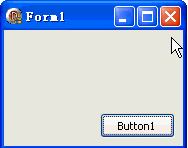本次专门研究下 SetWaitableTimer 的第二个参数(起始时间).
它有正值、负值、0值三种情况, 前面已用过 0值.
先学习负值(相对时间), 也就是从当前算起隔多长时间开始执行.
这个相对时间是以 1/100 纳秒为单位的, 譬如赋值 3*10000000 相当于 3 秒.
1 s(秒) = 1,000 ms(毫秒); 1 s(秒) = 1,000,000 µs(微妙); 1 s(秒) = 1,000,000,000 ns(纳秒); 1 s(秒) = 1,000,000,000,000 ps(皮秒);
本例效果图:

代码文件:
unit Unit1;
interface
uses
Windows, Messages, SysUtils, Variants, Classes, Graphics, Controls, Forms,
Dialogs, StdCtrls;
type
TForm1 = class(TForm)
Button1: TButton;
procedure Button1Click(Sender: TObject);
procedure FormDestroy(Sender: TObject);
end;
var
Form1: TForm1;
implementation
{$R *.dfm}
var
f: Integer;
hWaitableTimer: THandle;
function MyThreadFun(p: Pointer): DWORD; stdcall;
var
i,y: Integer;
begin
Inc(f);
y := 20 * f;
if WaitForSingleObject(hWaitableTimer, INFINITE) = WAIT_OBJECT_0 then
begin
for i := 0 to 1000 do
begin
Form1.Canvas.Lock;
Form1.Canvas.TextOut(20, y, IntToStr(i));
Form1.Canvas.Unlock;
Sleep(1);
end;
end;
Result := 0;
end;
procedure TForm1.Button1Click(Sender: TObject);
var
ThreadID: DWORD;
DueTime: Int64;
begin
hWaitableTimer := CreateWaitableTimer(nil, True, nil);
DueTime := -3*10000000; {3秒钟后执行}
SetWaitableTimer(hWaitableTimer, DueTime, 0, nil, nil, False);
Repaint; f := 0;
CreateThread(nil, 0, @MyThreadFun, nil, 0, ThreadID);
CreateThread(nil, 0, @MyThreadFun, nil, 0, ThreadID);
CreateThread(nil, 0, @MyThreadFun, nil, 0, ThreadID);
end;
procedure TForm1.FormDestroy(Sender: TObject);
begin
CloseHandle(hWaitableTimer);
end;
end.
窗体文件:
object Form1: TForm1
Left = 0
Top = 0
Caption = 'Form1'
ClientHeight = 116
ClientWidth = 179
Color = clBtnFace
Font.Charset = DEFAULT_CHARSET
Font.Color = clWindowText
Font.Height = -11
Font.Name = 'Tahoma'
Font.Style = []
OldCreateOrder = False
OnDestroy = FormDestroy
PixelsPerInch = 96
TextHeight = 13
object Button1: TButton
Left = 96
Top = 83
Width = 75
Height = 25
Caption = 'Button1'
TabOrder = 0
OnClick = Button1Click
end
end
当我们需要一个绝对时间时, 譬如 2009-2-18 13:10:5, 函数需要的 Int64 值应该是个 TFileTime 格式的时间.
先看三种相关时间类型(TFileTime、TSystemTime、TDateTime)的定义:
TFileTime(又名 FILETIME 或 _FILETIME) _FILETIME = record dwLowDateTime: DWORD; dwHighDateTime: DWORD; end; TSystemTime(又名 SYSTEMTIME 或 _SYSTEMTIME) _SYSTEMTIME = record wYear: Word; wMonth: Word; wDayOfWeek: Word; wDay: Word; wHour: Word; wMinute: Word; wSecond: Word; wMilliseconds: Word; end; TDateTime = type Double; //TFileTime 相当于一个 Int64, 一般要通过给 TSystemTime 或 TDateTime 赋值, 然后转换过去. //在例子中我是通过下面过程转过去的: StrToDateTime -> DateTimeToSystemTime -> SystemTimeToFileTime -> LocalFileTimeToFileTime
下面程序指定在 2009年2月18号下午1点10分5秒时运行三个线程(窗体同上, 我已找了个合适的时间测试成功).
unit Unit1;
interface
uses
Windows, Messages, SysUtils, Variants, Classes, Graphics, Controls, Forms,
Dialogs, StdCtrls;
type
TForm1 = class(TForm)
Button1: TButton;
procedure Button1Click(Sender: TObject);
procedure FormDestroy(Sender: TObject);
end;
var
Form1: TForm1;
implementation
{$R *.dfm}
var
f: Integer;
hWaitableTimer: THandle;
function MyThreadFun(p: Pointer): DWORD; stdcall;
var
i,y: Integer;
begin
Inc(f);
y := 20 * f;
if WaitForSingleObject(hWaitableTimer, INFINITE) = WAIT_OBJECT_0 then
begin
for i := 0 to 1000 do
begin
Form1.Canvas.Lock;
Form1.Canvas.TextOut(20, y, IntToStr(i));
Form1.Canvas.Unlock;
Sleep(1);
end;
end;
Result := 0;
end;
procedure TForm1.Button1Click(Sender: TObject);
const
strTime = '2009-2-18 13:10:5';
var
ThreadID: DWORD;
DueTime: Int64;
st: TSystemTime;
ft,UTC: TFileTime;
dt: TDateTime;
begin
DateTimeToSystemTime(StrToDateTime(strTime), st); {从 TDateTime 到 TSystemTime}
SystemTimeToFileTime(st, ft); {从 TSystemTime 到 TFileTime}
LocalFileTimeToFileTime(ft, UTC); {从本地时间到国际标准时间 UTC}
DueTime := Int64(UTC); {函数需要的是 Int64}
hWaitableTimer := CreateWaitableTimer(nil, True, nil);
SetWaitableTimer(hWaitableTimer, DueTime, 0, nil, nil, False);
Repaint; f := 0;
CreateThread(nil, 0, @MyThreadFun, nil, 0, ThreadID);
CreateThread(nil, 0, @MyThreadFun, nil, 0, ThreadID);
CreateThread(nil, 0, @MyThreadFun, nil, 0, ThreadID);
end;
procedure TForm1.FormDestroy(Sender: TObject);
begin
CloseHandle(hWaitableTimer);
end;
end.
接下来该是 WaitableTimer 对象的回调函数了.


 浙公网安备 33010602011771号
浙公网安备 33010602011771号